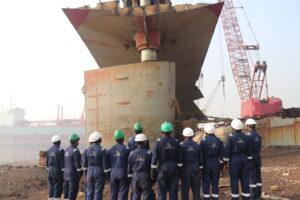- Leading ship recycling company and has been established in 1983
Understanding the Ship Breaking Process: From Ship Acquisition to Dismantling
The shipbreaking process is a responsible and efficient dismantling of large abandoned ships or vessels. The process comprises a series of detailed steps, beginning from ship acquisition to careful ship dismantling. There has always been an emphasis on the systematic dismantling of ships, with a focus on the safety, sustainability, and proper management of hazardous materials. R.L. Kalthia has brought this blog to help everyone in Understanding the Ship Breaking Process: From Ship Acquisition to Dismantling.
With growing awareness about the environmental impact of ship recycling, now the focus has shifted toward recycling end-of-life ships while ensuring the recovery of valuable material and minimizing the environmental impact. Let’s dive deep into the blog and understand how ship recycling takes place right from the beginning till the end. You will get a vivid account of a ship’s journey once it arrives at any shipbreaking yard.

Sourcing and Selecting Vessels for Shipbreaking Process with Ship Acquisition
The ship recycling process begins with the acquisition of ships for the dismantling process. Shipbreaking yards or companies opt for different methods to acquire ships for the recovery of scrap and other valuable items. Some common sources used by the shipbreaking yards to find a suitable end-of-the-life ship are:
- Decommissioned Navy and Military Vessels
- Government Auctions and Sales
- Merchant Ships
- Salvage Operations
- Ship Recycling Companies
To get the best deals yard owners or companies look for different ship acquisition methods. Mostly the ships are acquired through auctions or negotiations with ship owners or brokers to acquire vessels for breaking. The shipbreaking yards can also directly purchase the vessel from ship owners or brokers. Sometimes government secures a contract with shipbreaking yards for the acquisition of decommissioned naval or Coast Guard vessels.
Mandatory Preliminary Assessment
Before beginning the ship recycling all the vessels are made to go through a mandatory preliminary assessment. In the preliminary assessment, the condition of the ship is inspected to quantify the recoverable material and all the hazardous materials present on the ship. Once the inspection is done, the feasibility of dismantling the ship is assessed by professionals using various techniques.
The preliminary assessment allows the shipbreaking yards to evaluate the feasibility of recycling a particular vessel. It also provides useful insights into the condition of the ship, eventually helping in estimating the cost and value of steel, non-ferrous metals, and other recyclable components, contributing to the economic viability of the shipbreaking operation.
Breaking Down Ships Safely and Efficiently
Once the preliminary inspection is done, the ship is prepared for the dismantling process. The preparation begins with the removal and securing of fuel, oils, and hazardous substances recovered from the ship. An expert ensures that the shipbreaking facility has implemented all the environmental safeguards and spill prevention measures.

The dismantling process begins with the removal of loose items and other useful interiors of the ship. Using various cutting technologies such as torch cutting, plasma cutting, mechanical shearing, and segregation of the recovered material. After the ship is cut into manageable sections, these sections are further separated and divided based on the type of material such as steel sections are separated from non-ferrous metal components like copper, aluminum, and brass.
Once the segregation is done, the separated material is further processed for recycling. After the dismantling process, the steel sections are sent to steel mills, where they are melted down to be transformed into new products. Non-ferrous metals are recovered and sold to metal smelters for reuse. No shipbreaking is similar and each ship requires a specific dismantling process and cutting technologies depending on various factors. These factors include the size of the ship, available equipment, and the shipbreaking yard’s capabilities. Throughout the dismantling process, it is ensured that all the safety protocols and environmental regulations are followed o ensure the safety and welfare of the workers.
Tackling Hazardous Material Management
All the abandoned ships brought for ship recycling comprises hazardous material in different forms. This hazardous material if not handled properly can be a threat to marine wildlife or human life as well. Therefore, there is a need for a proper management system to dispose of the hazardous material recovered from the ships. Some common hazardous materials recovered from the ship recycling are:
- Asbestos
- Polychlorinated Biphenyls (PCBs)
- Lead-based Paint
- Hazardous Chemicals and Oils
- Fuel and Oil Residues
Ship recycling facilities employ trained professionals that follow the safety standards and ensure the safety of safe handling, containment, and disposal of hazardous materials.
Prime Focus on the Safety and Welfare of the Workers
Shipbreaking is a risky process that poses a threat to the life of workers, working in the shipbreaking yard. Ensuring the safety of all the workers involved in the shipbreaking process shall be a primary concern. To make it more safe adequate personal protective equipment (PPE) is provided to workers, and safety protocols are implemented throughout the dismantling process. Several training programs on occupational health and safety are conducted to educate the workers about potential hazards and safe practices. Compliance with labor laws, including fair wages and working hours, is essential to protect the rights of workers.
Conclusion
The ship recycling process is highly sophisticated and cannot be carried out without proper planning, and prioritizing the worker’s safety and environmental regulations. From the acquisition of ships to the dismantling process, all the activities shall be carried out as per international guidelines and regulations. Several efforts are made by the industry and international bodies to improve shipbreaking practices and promote the development of sustainable ship recycling facilities worldwide. You can reach R.L. Kalthia at info@kalthiashipbreaking.com to get more information on shipbreaking and related topics.